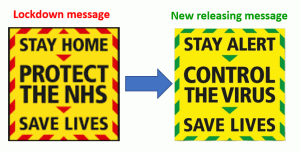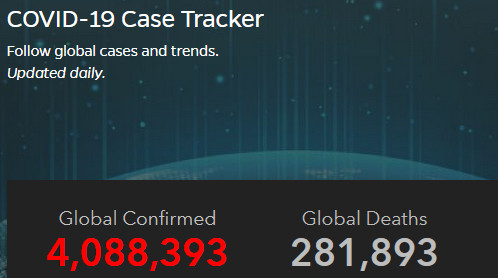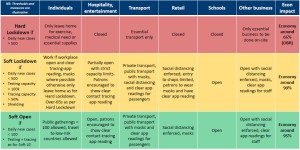Using technology for good – to help us ‘ease the lockdown’.
In terms of the coronavirus pandemic, week 7 was one in which we all speculated on what Boris would announce during his ‘address to the nation’ on Sunday by way of a ‘road map’ for lifting the restrictions. Lots of documents were ‘leaked’ and guidelines for certain businesses were published on the .gov.uk web site.
At the start of the week daily death totals (now in all situations) didn’t appear to be falling as quickly as many had hoped, but the last two days’ figures of 346 and 269 were lower, even for a Bank Holiday. By Sunday evening the number of lives lost was 31,855. On a purely numerical measure the UK is second to the US in terms of total deaths. There were more discussions on international comparisons. I have written in previous weeks about statistics and the difficulty of comparing countries. Factors such as the age profile, ethnic mix, housing density in cities, poverty and whether a country is an international ‘transport hub’ need to be considered.

Another topic that took up a lot of time during news bulletins and daily briefings was the launch of a ‘Track Test Trace’ (TTT) application for mobile phones. This is an example of ‘using technology for the good of society’.
On a basic level everyone who downloads the app to their smartphone can collect data about close contact with others who have the same app. ![]() If someone shows symptoms of infection by coronavirus they complete some details on the app and a central server sends a message to all of the people they have been in contact with over recent days informing them of steps they need to take. As with all ‘technology’ and especially programmes or apps, things are not so simple as I explain below.
If someone shows symptoms of infection by coronavirus they complete some details on the app and a central server sends a message to all of the people they have been in contact with over recent days informing them of steps they need to take. As with all ‘technology’ and especially programmes or apps, things are not so simple as I explain below.
My life using information technology for almost 40 years could be the subject of another blog. Even though one of my sons, now in his 30s, recently called me a ‘dinosaur’ for asking what I considered a reasonable question about how he implements systems in the complex world of on-line and mobile banking apps, I think my knowledge of the principles still stands me in good stead. I am proud of showing him and his brother before they got to secondary school, that there was more to computing than the games they played on our Atari console. This probably helped set them on the way to the complex systems they are responsible for now.
So I asked our two sons their professional opinion on the planned NHS TTT app development, its data usage and architecture. I read some articles with concerns around privacy, and the two departments party to it, the NHS and the intelligence agency GCHQ, not having a good track record with implementation of IT projects. GCHQ is all about surveillance so is the app as much about location as it is tracking the proximity of nearby devices?
Their reports were that most countries are going with an app produced by two of the largest technology companies, Google and Apple joining forces. They are promising an approach where all the data is stored ‘locally’ on the users device which also sends messages to the relevant contacts if required. No central data is held on individuals. Their ownership of the two operating systems that all smartphones use, means they can maximise the efficiency of the Bluetooth file transfer exchanges and minimise the use of battery power on the devices. It is this deep technical knowledge that may cause other countries, including the UK, problems in developing their own.
An example of the problem is that in its standard form Google and Apple restrict apps from broadcasting Bluetooth constantly, as this has been exploited by companies connecting and sending targeted advertising. This means that most apps only broadcast if they are running in the ‘foreground’ or looking at it. If your phone is locked or you are not actively using the app there is a danger that some interactions will not be registered. There is some debate as to what counts as an ‘interaction’ is it that you are close to someone for a certain time such as five minutes, or just when you pass by on the street?
Michael found an article referring to a petition by developers to the French government demanding that there is complete openness on privacy, asking for published details of exactly what sort of data is collected, how it is used and when it will be destroyed after use. This is part of the ‘privacy v health’ debate around such applications. The UK government wants to use data to track the areas the virus is spreading. David’s ‘research’ concentrated on battery life and foreground running. He says that with Bluetooth there is something called “Received Signal Strength Indication” to determine distance between devices, but it’s not particularly accurate. This probably means there will be a lot of false positives, and even cases where it’s picked up a neighbour’s signal through a flat or house wall.
Whatever the pros and cons of the privacy debate, my concerns are about the practicalities of the system.
- What incentive is there to report symptoms when people get them?
- Alternatively what stops someone maliciously reporting symptoms if they are so minded just to cause a nuisance?
- Is there a necessity for a positive test before the messages get sent and if not won’t the ‘false positives’ cause a lot of unnecessary disruption?
- Given that a lot of people will go to a supermarket once a week, many ‘contacts’ will take place. The consequence is that one or two customers getting symptoms can lead to many supermarket workers having to isolate. Similarly, one supermarket worker getting symptoms could lead their fellow workers and hundreds of customers isolating. The result, after a few days, could be no supermarkets open and no customers going in.
- Most transmission currently seems to be taking place in hospital and care home settings where there are lots and lots of ‘contacts’, so I am not sure how practical it is to use the app in those areas. Most medical staff take care not to contact people at home or outside the work situation anyway.
The biggest problem with the TTT system is the same as with the current hard lockdown. If there is a large minority who don’t engage or download the app, and they are the ones responsible for being lax on other ways of controlling the spread of the virus, they will still be responsible for causing some ‘needless’ cases and deaths.
We await the results of the Isle of Wight larger scale test but given that we have been told the app will be available to us ‘by the middle of the month’ there doesn’t appear to be much time to analyse how the system is working.
Readers of this blog know I love an initialism, so the last word goes to the writer of a blog three days ago suggesting countries trying to develop a (deep breath..) Pan-European Privacy-Preserving Proximity Tracing app or PEPPPT, will find themselves changing course and adopting the Apple-Google model. He predicted that by the end of the month the UK will have done so.
Is the change in message another sign that we are in for a long haul?
If today’s papers are to be believed Boris’s ‘address to the nation’ this evening will change the message we have been used to seeing as illustrated below.
The not so subtle change from red to green along with a ‘traffic light system’ for alert levels suggest to me that we are in for a period of trying changes, and if they don’t work putting restrictions back on. If, as has been trailed in the press, there are a whole variety of ways that businesses, workplaces, schools and social situations will change, then confusion (and some anger and worry) could be widespread. The words of epidemiologist Professor Peter Horby interviewed on The Andrew Marr Show stood out to me. He is chair of New and Emerging Respiratory Virus Threats Advisory Group or NERVTAG – sorry folks it is too lovely an acronym to ignore. He stated
the virus is not like a storm or hurricane where we batten down the hatches until it has passed by, and then emerge into the sunshine and it has gone. It’s still out there and most of us have not had this virus, so if we get this wrong it will very quickly increase across the population and we will be back in a situation of crisis. So we have to be incredibly cautious about relaxing the measures.
NERVTAG told the government that getting the relaxation wrong could lead to a figure of 100,000 deaths in the UK. We still don’t know the proportion of the population who have had covid-19, but if the professor is correct there might be a lower but steady number of deaths for many more months yet.
The fact that the extra Nightingale Hospitals haven’t been closed is probably a sign that the politicians expect if not a ‘second wave’, then a lot more cases. As well as balancing privacy vs health for the new tracking app, there is even more pressure to balance health vs the economy.
Finally, on Sunday evening we listened to Boris address the nation. He set out the way the five ‘alert levels’ would be set by monitoring the R-level by an advisory group. He set out timescales for now, the end of May, end of June when certain parts of the economy such as construction, manufacturing, garden centres, shops, and eventually limited hospitality would restart.
He encouraged anyone who can’t work from home to return to work tomorrow, and from Wednesday encouraged everyone to take more exercise and play sport with their family.
However, the main ‘confusions’ straight after the announcements were;
- How people, who the prime minister said should go ‘back to work’ if they could the next day, would get there given limited public transport.
- The other nations of the UK have announced that they are sticking with the ‘old message’ about staying at home. Scottish First Minister Nicola Sturgeon even asked the UK government not to run the information ads in Scotland. In Wales where you can’t drive for exercise, people from England could get fined for driving to the Brecon Beacons for exercise. Do Welsh workers need to drive to England if their employer decides that they need to work?
- The detailed instructions for all sorts of workplaces have not been set out, so it is uncertain how that might look.
We will see what happens in the coming week with clarification and further statements to parliament on Monday, and questions from the public in the daily briefings.
Other news this week.
- VE Day was celebrated in a ‘socially distancing’ way on Friday 8th May. The 75th anniversary was a special one and street parties held, and old-time songs sung. An evening concert held at Buckingham Palace featured a ‘virtual duet’ with Katherine Jenkins and Dame Vera Lynn of the wartime favourite ‘We’ll Meet Again’. One lady told the story that on the original VE Day she and her sister had to ‘socially distance’ and sit on a separate table as they had mumps, and she didn’t think that 75 years later she wouldn’t be able to join in a street party due to social distancing again.
- In last week’s blog I wasn’t having a go at radio DJ Chris Evans specifically over his fundraising efforts. I listen to Virgin Radio’s Breakfast Show most mornings and Chris and his team try to spread joy and positivity in these difficult times. He has also been party to raising literally tens of millions of pounds during his time at Radio 2 and Children in Need auctions and events. Chris by his own admission comes from ‘humble roots’, found fame and has had his well-documented ‘excesses’. But he tries to see the best in people and teach others lessons he has learned. The message from last week was that our much-needed public services should be properly funded by us all and not rely on the charity and voluntary sectors. Chris, his family and many celebrity friends have now raised in excess of £1 million from two auctions of memorabilia, and his son Noah over £100,000 by sleeping in a den in the garden. This money will go to producing more than 220,000 sets of scrubs for the NHS workers.
- On Friday transport minister Grant Shapps gave news of a £2billion scheme to encourage us to cycle or walk to work. For people travelling on public transport to maintain social distancing then they need to run at about 10% capacity.
- Other countries started to ease their lockdowns and in Germany Chancellor Angela Merkle allowed all shops to reopen, pupils are gradually returning to classes, and the Bundesliga – the country’s top football league – will restart next weekend. Initial signs are not promising as the dreaded R-number, a measure of the number of people each confirmed patient infects – moved to above 1.
Thoughts at the end of week 7
We continue to enjoy good health and the warm weather meant we ate a few meals outside. Alyson planted more seeds and worked on the garden. I managed to put the last shelf up in our shed in under an hour!
After finishing Terry Waite’s book Alyson has started the one by John McCarthy and Jill Morrell ‘ Some Other Rainbow‘ that documents the same time and similar events. We have been watching some more ‘culture’ on YouTube with recorded performances of Shakespeare and ‘Frankenstein’ by The National Theatre.
At today’s live stream service from Methodist Central Hall, Rev Martyn Atkins talking about being ‘salt and light’ referenced a talk he had heard where a student illustrated Christians being all shapes and sizes of candle, some battered, some old, some coloured – but all shining as a light to others. Something we are called to do at this time. One of his daughter’s friends when she was frightened would ask her dad to ‘turn off the dark’! We needed to use the battered candle I display some Sunday evenings to remember our carers as we had a power cut on Saturday evening.
We have had the usual Zoom meet up with friends and family. The week coming up is both Christian Aid Week and Brain Injury Awareness Week, so I have two ‘Zoom quizzes’ to prepare and host.
Alyson is hoping to get back to ‘frontline’ work by helping the NHS 111 Service and doing calls to patients who have been referred to a pharmacist for advice. She has been training and is waiting on information on how to setup a ‘call centre’ from her study – i.e. our spare bedroom.
I am a follower of a blog by the wonderful modern poet Brian Bilston and if you have never seen his work I can recommend you looking him up. He has produced some thought-provoking work over these last few weeks and I leave you with one of my favourites;
On Leaving the House and Encountering Another Human Being
I’m sorry I dived into the bushes.
It’s not personal, you understand.
You happened to walk in my direction
and my nerves got the upper hand.
I’m sorry I screamed when you came near me.
Don’t take my angry shrieks to heart.
Idiomatically, let’s stay in touch –
and physically, six feet apart.
Apologies if it seems like you repulse me,
that I recoil when you come near.
In other times, we might have spoken,
shared a joke or had a beer,or waltzed together down the footpath,
perhaps we may yet still one day.
But just for now, embrace the margins
and wave to me from far away.


 Nicola Sturgeon Scotland’s First Minister released a similar document to start what she called an ‘adult discussion’ about the gradual release of restrictions. For example, on how schools might have to be adapted to keep social distancing measures. One of the opposition parties in Scotland claimed that this was as much to do with trying to have a separate track from the UK government, and to steal a march on the ‘English Parliament’, as it is a real attempt to plan.
Nicola Sturgeon Scotland’s First Minister released a similar document to start what she called an ‘adult discussion’ about the gradual release of restrictions. For example, on how schools might have to be adapted to keep social distancing measures. One of the opposition parties in Scotland claimed that this was as much to do with trying to have a separate track from the UK government, and to steal a march on the ‘English Parliament’, as it is a real attempt to plan.